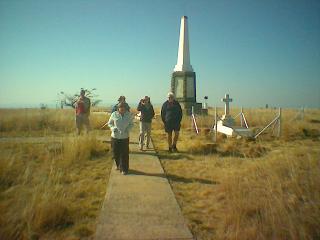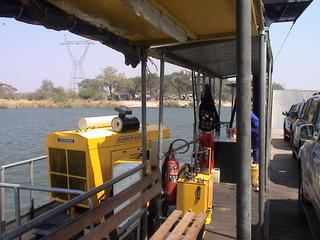
Snow in Africa!
Tiffindell ski resort in the Drakensburg Mountains
All along the road cars from the event stopped to take pictures of the wonderful landscape. The drive down the mountain was not so steep but the view across the valley below was breathtaking.

On the way down from Tiffendell, looking towards Lesotho
Our drive then took us along the border with Lesotho, passing villages that cannot have changed in hundreds of years. Small round thatched houses, painted in many different colours with children running all over the place. Everyone is so friendly and waves as we pass by. The only problem we have is that the children run into the road to try and stop us to get money or food. We made the mistake of stopping and handing out colouring pens but soon realised that once you start doing this then children appear from everywhere and you simply cannot satisfy them all.
We arrived at the border at 10.45am and quickly entered Lesotho. John Brown's car was there with us as were the Mitchell's and the de Hullu's in their Landrover.

Crossing into Lesotho from South Africa
The scenery in Lesotho is truly impressive. The country is mainly above 5,000 feet and the mountains all around make an impressive backdrop to the wide open spaces. The hills are dotted with small villages and goat herding and some corn growing seemed to be the main activity. It is quite obvious that the majority of the population are very poor. A sobering sight was to see so many placards giving HIV/Aids warnings and it seemed to us that in every small town the only businesses that advertised were undertakers. The aids problem is huge in South Africa and it is only when you come face to face with the reality of the situation that you realise how much damage is being done to the lives of these people and to the economies of these poor countries.
We traversed more passes and lunched at a really out of the way holiday lodge, the Malelela. Great lunch and the usual spectacular views we have come used to on our drive. Three hours of hard driving took us to the captial, Maseru and our hotel, the Lesotho Sun.
So far everyone is getting round OK and apart from a few punctures no one has suffered badly. Some of the hired Nissans have front guards that are coming loose, but apart from that all seems OK.
Tomorrow we cross Lesotho and head back into South Africa at the Sani Pass. Hopefully I will be able to post again then but the mobile signal in remote areas is not 100% certain. Reminds me of trying to get a signal in parts of London!





 Unfortunately the Weening family Landrover broke down and, at the time of writing this, I am not sure if they have managed to make it to the hotel. Our journey ended at 3pm when we crossed back into South Africa and drove the 20 kms to the Sani Pass hotel.
Unfortunately the Weening family Landrover broke down and, at the time of writing this, I am not sure if they have managed to make it to the hotel. Our journey ended at 3pm when we crossed back into South Africa and drove the 20 kms to the Sani Pass hotel.

 Jingers with Dave Mitchell fitting new shock absorbers to the Nissan
Jingers with Dave Mitchell fitting new shock absorbers to the Nissan







 The beautiful Nyala
The beautiful Nyala














 On the ferry back across the Zambezi to Botswana
On the ferry back across the Zambezi to Botswana Waiting to take the boat for our Chobe river safari
Waiting to take the boat for our Chobe river safari












 Each permanent waterhole we came across teemed with life. The birds would fly down in large flocks to drink, whilst giraffes bent down their long necks to reach the water. You simply could never get bored watching.
Each permanent waterhole we came across teemed with life. The birds would fly down in large flocks to drink, whilst giraffes bent down their long necks to reach the water. You simply could never get bored watching.
 Wildebeest seemed to spend most of their time resting in the shade of small trees and bushes, like the one above.
Wildebeest seemed to spend most of their time resting in the shade of small trees and bushes, like the one above.

 After six hours we exited the park and drove the final 100 kms to our overnight stop in Outjo. For the past four days we have been heading more or less due west. Today we started the long drive south to Cape Town and tomorrow we reach the Atlantic at the feared Skeleton Coast. The first time we will see the sea since we headed inland at Port Elizabeth over two weeks ago.
After six hours we exited the park and drove the final 100 kms to our overnight stop in Outjo. For the past four days we have been heading more or less due west. Today we started the long drive south to Cape Town and tomorrow we reach the Atlantic at the feared Skeleton Coast. The first time we will see the sea since we headed inland at Port Elizabeth over two weeks ago.